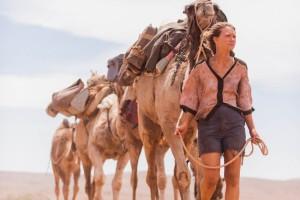
Mia Wasikowska as Robyn Davidson, who treks across Australia with her feral camels in ‘Tracks.’
★★★☆☆
I am fairly confident that the majority of Georgetown students have never given much thought to the terrifying nature of feral camels. If you’d like that to change, I suggest you see “Tracks,” directed by John Curran (director of “The Painted Veil”). The film follows the true story of a woman named Robyn Davidson (Mia Wasikowska) who treks 1,700 miles across Australia with three feral camels and her beloved dog, Diggity, in the hopes of making it to the Indian Ocean. Aside from the interesting camel factor, “Tracks” is a superbly acted, poignantly genuine narrative of self-discovery.
Davidson first decides to embark on her journey to escape the humdrum of daily life in the city and “be alone with [her] animals,” as she puts it. Ironically, there are quite a few scenes in which a glum, disaffected Davidson whines that her generation is too glum and disaffected. While it would be easy to write her off as just another modern youth with a penchant for complaining, Davidson quickly proves her seriousness by working for months on feral camel farms before she leaves for her trip. When she finally sets off, it’s difficult to doubt her sincerity in achieving her mission.
Wasikowska’s performance can appear monotonous at times, but this intentional apathy hints at a personality hiding within Davidson. When it’s least expected, we get subtle smiles or genuinely funny comments to the camels that make us laugh and sympathize with Davidson. As “Tracks” treks on, her indifference actually begins to appear more as perseverance. However, it’s difficult to be a consistent fan of Davidson, as she oscillates between frustratingly self-indulgent and admirably levelheaded. She turns her nose up at help, scoffs at people’s concern for her safety, and reacts with feigned shock when tourists and reporters attempt to stop her for photos. Yet there’s a certain charming honesty to Davidson that keeps us in her corner throughout the film.
Adam Driver plays Rick Smolan, a wonderfully gawky National Geographic photographer who meets Davidson at various points to take photos of her journey, much to her disdain. Driver’s performance is so captivatingly candid and real that it’s easy to forget his past role as an insensitive jerk on “Girls.” His character Smolan is a breath of fresh air, contrasting perfectly with Davidson’s mellow silence as he talks almost continuously. The choreography of their scenes together is nothing short of marvelous to watch; the camera humorously cuts to different angles of him trailing on incessantly so as to mimic a conversation between two people. This tactic emphasizes the fact that he encapsulates everything Davidson detests: quick talking, meaningless filler phrases, stuttering and awkwardness.
The cinematography of “Tracks” gives an insightful perspective on Davidson’s view of the world. There are many sequences of slow, singular motion focused on a specific facial feature (like people’s lips as they talk or their eyes half-shut as they smoke). Davidson’s spacy disillusionment becomes more understandable when we see through the camera the dreamlike world that she sees. These scenes are supplemented with similarly-styled flashbacks of Davidson’s childhood tragedies. The deft cinematography of “Tracks” is the closest we get to fathom the inner workings of Davidson’s mind.
Why did Davidson decide to go on such a treacherous journey, casting off all material possessions and human connections? The film never really gives a substantial answer, other than the unsatisfying cliché of “why not?” which Davidson says flippantly at the beginning of the film.We are left to assume that she did it to escape people and modernity, although the question of what happens after she finishes the journey hangs over the film. This lack of a clear motive leaves some aspects of Davidson’s character feeling underdeveloped when “Tracks” ends. She’s the type of person you always want to get just a bit more out of, but of course she’ll never oblige.
For all the potential frustration in “Tracks,” it’s truly a thought-provoking journey which transports the audience to a completely foreign place both physically and mentally. One of the film’s most striking commentaries relates to the excess of communication in modern society So uncomfortable with our own silence, we would rather talk nonstop and say things devoid of meaning rather than listen to nothing at all. This idea is especially relevant to college students, who live hooked in to technology and constant streams of superficial conversation. If there’s one thing a viewer can take from “Tracks,” it’s a sense of calm and peace. And isn’t that worth two hours of your life? Just watch out for the camels.














